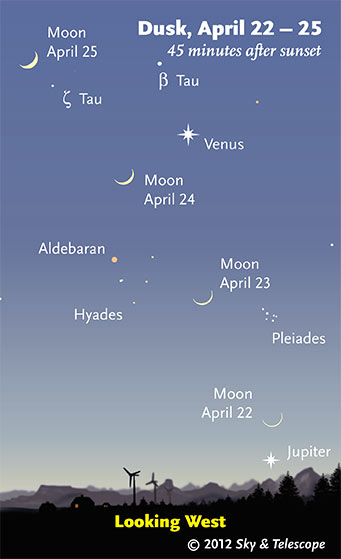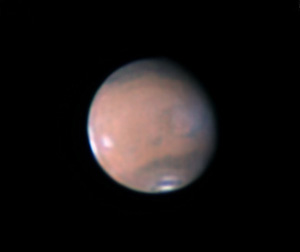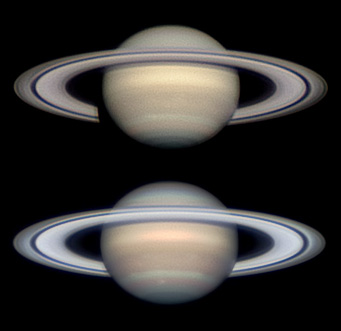Friday, April 20
Saturday, April 21

The waxing Moon emerges out of the sunglow to march past Jupiter and bright Venus in evening twilight. The visibility of the fainter objects in bright twilight is exaggerated here. (These scenes are drawn for the middle of North America. European observers: move each Moon symbol a quarter of the way toward the one for the previous date. For clarity, the Moon is shown three times actual size.)
Sky & Telescope diagram
Sunday, April 22
Monday, April 23
Tuesday, April 24
Wednesday, April 25
Thursday, April 26
Friday, April 27
Saturday, April 28
Want to become a better amateur astronomer? Learn your way around the constellations. They're the key to locating everything fainter and deeper to hunt with binoculars or a telescope.
For an easy-to-use constellation guide covering the whole evening sky, use the big monthly map in the center of each issue of Sky & Telescope, the essential magazine of astronomy. Or download our free Getting Started in Astronomy booklet (which only has bimonthly maps).
Sky Atlas 2000.0 (the color Deluxe Edition is shown here) plots 81,312 stars to magnitude 8.5. That includes most of the stars that you can see in a good finderscope, and typically one or two stars that will fall within a 50× telescope's field of view wherever you point. About 2,700 deep-sky objects to hunt are plotted among the stars.
Alan MacRobert
Once you get a telescope, to put it to good use you'll need a detailed, large-scale sky atlas (set of charts). The standards are the little Pocket Sky Atlas, which shows stars to magnitude 7.6; the larger and deeper Sky Atlas 2000.0 (stars to magnitude 8.5); and the even larger Uranometria 2000.0 (stars to magnitude 9.75). And read how to use sky charts effectively.
You'll also want a good deep-sky guidebook, such as Sue French's Deep-Sky Wonders collection (which includes its own charts), Sky Atlas 2000.0 Companion by Strong and Sinnott, the bigger Night Sky Observer's Guide by Kepple and Sanner, or the classic if dated Burnham's Celestial Handbook.
Can a computerized telescope replace charts? I don't think so — not for beginners, anyway, and especially not on mounts and tripods that are less than top-quality mechanically (able to point with better than 0.2° repeatability). As Terence Dickinson and Alan Dyer say in their invaluable Backyard Astronomer's Guide, "A full appreciation of the universe cannot come without developing the skills to find things in the sky and understanding how the sky works. This knowledge comes only by spending time under the stars with star maps in hand."
This Week's Planet Roundup

Mars was only 10.8 arcseconds wide on the evening of April 22nd, when Sean Walker shot this stacked-video image using his 12.5-inch reflector in New Hampshire. South is up. Note the divided little North Polar Cap, and the bright clouds over Tharsis at the preceding limb (left).
S&T: Sean Walker
Mercury (about magnitude +0.1) is deep in the glow of sunrise, having a very poor dawn apparition just above the eastern horizon.
Venus (magnitude –4.7, in Taurus) is blazing the highest and brightest it ever appears in its 8-year cycle of repeating apparitions. It comes into easy view high in the west right after sunset, and doesn't set in the northwest until around 11 or even midnight daylight saving time. You can see Venus through the clear blue sky of day if your eye lands right on it; look for it 42° (about four fist-widths at arm's length) to the Sun's celestial east-northeast.
Look high to Venus's upper right at dusk for Capella, to its lower left for Aldebaran, and farther to its lower right for the Pleiades. Far beneath Venus, Jupiter is sinking into the sunset.
The best time to examine Venus in a telescope is late afternoon or around sundown. It's now a thick crescent 33 arcseconds tall and 33% sunlit, waning and enlarging week by week as it swings closer to Earth. Venus will transit the face of the Sun on June 5–6 (the afternoon of the 5th for North America).
Mars (magnitude –0.2) shines fire-orange in Leo, high in the south at dusk and southwest later in the evening. Regulus is 5° to Mars's right or lower right. Fainter Gamma Leonis is 8° above them. Mars in a telescope is gibbous and small, 10.5 arcseconds wide, fading and shrinking weekly.
Jupiter (magnitude –2.0, in Aries) is lowering into the sunset far below Venus.

Yes, the Seeliger effect is for real. Christopher Go took these images on February 23 and April 13, 2012. The latter was two days before Saturn's opposition. The brightening of the rings with respect to the globe shows that the rings are made of solid grains (which backscatter light) and Saturn's cloudtops are not. South is up.
Saturn (magnitude +0.2, in Virgo) was at opposition last week, on April 15th. It shines low in the east-southeast in twilight and highest in the south around midnight or 1 a.m. Sparkling 5° to its right in the evening is Spica, slightly fainter, bluer, and twinklier.
With Saturn past opposition, say goodbye to the Seeliger effect, the opposition brightening of Saturn's rings.
Uranus is hidden low in the dawn.
Neptune (magnitude 7.9, in Aquarius) is emerging into view low in the east-southeast before dawn's first light.
All descriptions that relate to your horizon — including the words up, down, right, and left — are written for the world's mid-northern latitudes. Descriptions that also depend on longitude (mainly Moon positions) are for North America. Eastern Daylight Time (EDT) equals Universal Time (also known as UT, UTC, or GMT) minus 4 hours.
Like This Week's Sky at a Glance? Watch our new weekly SkyWeek TV short. It's also playing on PBS!
To be sure to get the current Sky at a Glance, bookmark this URL:
http://SkyandTelescope.com/observing/ataglance?1=1
If pictures fail to load, refresh the page. If they still fail to load, change the 1 at the end of the URL to any other character and try again.
 0
0
Comments
You must be logged in to post a comment.